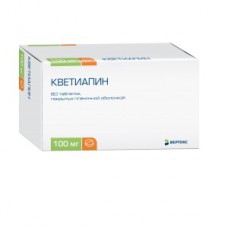Expiration date: 11/2026
Release Form
Pills
Composition
One tablet contains quetiapine fumarate 100 or 200 mg,
Excipients: giproloza (Klutsel hydroxypropylcellulose LF), calcium hydrogen phosphate dihydrate, pregelatinized starch, magnesium stearate, sodium carboxymethyl starch (sodium starch glycolate, Primogel), microcrystalline cellulose
Packaging
60 pcs.
pharmachologic effect
Quetiapine - antipsychotic (neuroleptic). It exhibits a high affinity for the serotonin receptors (5-HT2), than to the D2 receptors and the D1 dopamine in the brain. It has a tropism for histamine and alpha 1-adrenergic receptors, less active in relation to the alpha2-adrenoceptor. Not detected selective affinity
m-choline and benzodiazepine receptors. Reduces the activity-A10 mesolimbic dopaminergic neurons, compared with the A9-nigrostriatal neurones involved in motor function. There is no long-term increase prolactin concentrations. Duration connection with 5-HT2-serotonin and D2-receptors dofami-new is less than 12 hours.
testimony
Acute and chronic psychosis (including schizophrenia), manic episodes of bipolar disorder in the structure.
Contraindications
Hypersensitivity to any component of the drug.
Dosing and Administration
Inside, 2 times a day, regardless of meals.
Treatment of acute and chronic psychosis, including schizophrenia.
The daily dosage for the first 4 days of treatment - 50 mg (Day 1), 100 mg (Day 2), 200 mg (Day 3), 300 mg (Day 4). Starting from day 4, the dose should be titrated to an effective, ranging from 300 to 450 mg / day, if necessary - up to 750 mg / day.
Treatment of manic episodes of bipolar disorder in the structure.
Quetiapine is used as monotherapy or as adjunctive therapy to mood stabilization.
The daily dosage for the first 4 days of treatment - 100 mg (Day 1), 200 mg (Day 2), 300 mg (Day 3), 400 mg (Day 4). Subsequently, by the 6th day of treatment the daily dose can be increased to 800 mg. Increasing the daily dose should not exceed 200 mg per day.
Depending on the clinical effect and individual tolerability, the dose can vary from 200 to 800 mg / day. Typically, the effective dose is from 400 to 800 mg / day.
For the treatment of schizophrenia, the maximum recommended daily dose is 750 mg of quetiapine in the treatment of manic episodes of bipolar disorder in the structure of the maximum recommended daily dose of quetiapine was 800 mg / day.
In renal and / or hepatic insufficiency and in the elderly initial dose - 25 mg / day, followed by the daily increase of 25-50 mg to achieve an effective dose.
Side effects
From the nervous system: drowsiness, dizziness, headache, anxiety, fatigue, hostility, agitation, insomnia, akathisia, tremor, convulsions, depression, paresthesia, neuroleptic malignant syndrome (hyperthermia, muscle rigidity, altered mental status, the lability of the autonomic nervous system, increase in creatine phosphokinase activity).
Since the cardiovascular system: orthostatic hypotension (dizziness accompanied by), tachycardia, syncope, prolongation of the interval QT (quetiapine relationship with the steady increase in QTc is not revealed).
From the digestive system: dryness of the oral mucosa, nausea, vomiting, abdominal pain, diarrhea or constipation, increased activity of "liver" transaminases.
The respiratory system: pharyngitis, rhinitis.
Allergic reactions: skin rash, eosinophilia.
Laboratory findings: leukopenia, hypercholesterolemia, hypertriglyceridemia, lowering the concentration of thyroxine (first 4 weeks).
Other: back pain, chest pain, low-grade fever, weight gain (especially in the first weeks of treatment), myalgia, dry skin, impaired vision.
Drug interactions
When concomitant administration of drugs possessing a strong inhibitory effect naCYP3A4 (such as azole antifungals group and macrolide antibiotics), quetiapine plasma concentrations may be increased.
In such cases it is necessary to use lower doses of quetiapine. Particular attention should be given to the elderly and immunocompromised patients. You must individually assess the risk-benefit ratio for each patient.
Inductors microsomal liver systems (. Phenytoin, etc.), thioridazine increase quetiapine clearance, inhibitors of microsomal liver systems - reduce, while co-administration of quetiapine and antidepressants - imipramine (an inhibitor of CYP2D6) or fluoxetine (an inhibitor of CYP3A4 and of CYP2D6) has no significant effect on its pharmacokinetics.
The pharmacokinetics of quetiapine were not significantly changed, while the appointment with the antipsychotics risperidone or haloperidol.
There is no induction of liver enzyme systems involved in the metabolism of antipyrine.
The pharmacokinetics of lithium products does not change with concomitant administration of quetiapine.
There were no clinically relevant changes in the pharmacokinetics of valproic acid and quetiapine with a joint appointment divalproeksa sodium (sodium valproate and valproic acid in a molar ratio of 1: 1), and quetiapine.
Drugs that suppress the central nervous system, and ethanol increase the risk of side effects.
Storage conditions
In a dry, dark place at a temperature no higher than 25 ° C.


